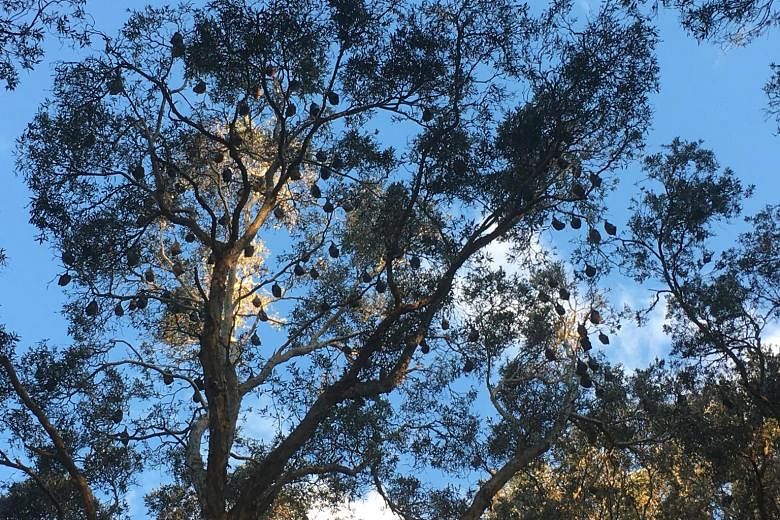Walking in Australian cities at night, pedestrians sometimes hear a flutter before a dark creature brushes past their faces and disappears back into the darkness.
It may sound like a scene from a horror film but it is reality for residents across Australia, which has seen sudden spikes in the bat population in some areas.
The latest surge occurred in Brisbane, where about 50,000 bats have descended on the quiet northern suburb of Wilston over eight weeks.
Residents have complained about the pungent smell and noise, especially as the bats leave their roost after sunset.
"I've got three young children. I would hate for a bat to run into them or scratch or bite them," a caller told ABC Radio.
The authorities say little can be done to limit the bat population, other than to cut down trees.
Such spikes have been on the rise in urban areas along the coast.
While the bats are a nuisance, experts say they pose little threat and actually play a crucial role in preserving the environment by moving pollen and seeds over long distances.
The culprit in Brisbane is the grey-headed flying fox, one of four native Australian species of the Old World fruit bat. Weighing up to 1kg, it is one of the largest bats in the world.
Researchers say the population is on the decline. However, their presence has been more noticeable because they have moved to urban areas, where a variety of plants and trees provide a year-round source of nectar and pollen.
In addition, a loss of native forest and vegetation in rural areas has made their survival more precarious, and encouraged the bats to seek green pockets in cities and towns.
Dr Anja Divljan, an expert on mammals at the Australian Museum whose PhD focused on flying foxes, said the creatures feed for several months off native trees, particularly eucalypts, before moving on when the food runs out. Now, they stay longer in specific spots, mainly in coastal urban areas.
"The problem of large colonies does tend to be getting worse," she told The Sunday Times.
"The main problem with cities is that people have often planted exotic fruit trees.
"There is always something flowering in urban environments and you then have an all-year-round food resource for the animals."
Dr Divljan added: "On top of that, we are destroying their natural habitats and native forests, so the animals don't have as much choice."
This move has exposed the bats to more dangers, including power lines, fencing, barbed wires, or being struck by planes.
The population of the grey-headed flying fox has declined from millions a century ago to about 500,000 to 680,000. It is officially listed as vulnerable to extinction.
But the dwindling numbers would surprise many on the densely populated east coast. In the beach town of Batemans Bay, south of Sydney, residents experienced a sudden invasion of about 120,000 bats earlier this year.
The area's MP, Mr Andrew Constance, called it a "natural disaster".
Residents tried playing extremely loud industrial noise, emitting smoke, shining bright lights, spraying trees with deterrents and using inflatable "waving men".
Combined with the cold weather and dwindling food sources, this helped to drive many bats away.
However, Mr Lindsay Usher, Eurobodalla Shire Council's director of planning and sustainability services, warned that they will almost certainly return when the weather turns warm and food supplies become available.
Experts say dispersing bats is not a long-term solution as they often return or move to nearby leafy areas.
In 2013, Sydney's Royal Botanic Garden scared off most of its bats with heavy metal music and loud banging at dawn. But many are now believed to have settled in other leafy areas in and around Sydney.
During a visit last week to Centennial Park, a popular inner-city parkland, thousands of bats could be seen dangling from trees near a marshy pond.
As the sun set, the bats flew off, filling the sky with a screeching racket. Their numbers are believed to be about 15,000.
Most experts believe it is best to focus on long-term solutions such as managing the roosts.
Fortunately, the bats typically do not attack humans and rarely spread disease. Dr Divljan said such fears are an "urban myth".
"They are quite intelligent and very inquisitive," she said. "They would not fly low and attack a moving object. I think of them as dogs that are upside down."

